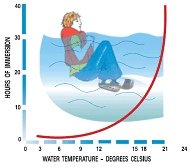Hypothermia
The term ‘hypothermia’ means lowering deep-body or core temperature. ‘Immersion hypothermia’ is an acute type of hypothermia produced when a person is immersed in cold water.
An adult of average build could not expect to survive more than three hours of immersion in midwinter. The time is very short when you consider the time lost before a search and rescue operation is under way.
The heat escape lessening posture (HELP) combats hypothermia and can be a lifesaver to people in cold water.
The HUDDLE position can also be used if there is more than one person in the water. To reduce body heat loss, make sure you stay close (huddle together) and remain still.

WARNING: the consumption of alcohol, attempting to swim or movement in the water will cause the body to use up heat rapidly, which will hasten the onset of hypothermia.
When recovering a person from cold water, keep them lying down if at all possible to reduce the load on the heart. Treat the cold person as for hypothermia and watch carefully for breathing difficulties due to intake of water.
Key points for treating hypothermia
1.Remove the person from the cold-inducing environment
2.Protect the person from cold wind
3.Remove wet clothing if practical
4.Warm victim with dry blankets, towels or skin-to-skin contact
5.Warm the area of high heat loss, that is, head and neck, sides of chest, armpits, and groin. Do not warm, rub or massage limbs
6.Observe the person for deterioration in condition
7.Manage an unconscious person by placing them in the lateral position, making sure their airway is clear. Continue warming procedures
8.Do not give the person alcohol
9.Do not allow the person to walk around
10.Seek medical assistance.
